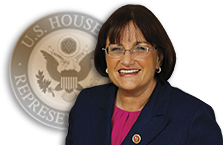Press Releases
Kuster, Larsen Introduce Bill to Enhance Federal Response to Close Substance Use Care Gap and Save Lives
Washington,
October 23, 2024
Washington, D.C. – Representatives Annie Kuster (NH-02) and Rick Larsen (WA-02) introduced the Closing the Substance Use Care Gap Act to expand access to lifesaving, community-based harm reduction initiatives and services and enhance the federal response to the opioid and fentanyl epidemic. The Closing the Substance Use Care Gap Act would provide community-based organizations with more resources to administer life-saving harm reduction programs and services to people struggling with substance use. The bill would provide grant funding to support low-barrier health care options like naloxone (an overdose reversal medication), fentanyl test strips, and low-threshold buprenorphine initiation to treat addiction. It would also provide funding to organizations to establish procedures and mechanisms for connecting individuals with evidence-based treatment and recovery support services. “At a time when overdose deaths are finally falling in New Hampshire and across the country, it’s essential we keep our foot on the gas pedal and use every tool at our disposal to help save lives,” said Kuster. “I’m pleased to help introduce legislation that bolsters access to community-based harm reduction services, overdose reversal medications, and medication-assisted treatments so that we connect more communities with the treatment and recovery services they need to heal and recover.” “The opioid crisis is devastating Northwest Washington. This bill helps close the gap between members of our community who want treatment for substance use disorder and those who actually receive it,” said Larsen. “Congress must stay focused on breaking down barriers to effective community-based solutions that meet people where they are, prevent overdoses and save lives.” “EMS clinicians and medical directors are on the front lines of the opioid crisis in our country, caring for our most vulnerable patients and responding to the urgent needs of our communities. There is an ongoing need for federal support to enhance harm reduction programs and to ensure early access to addiction treatment for those suffering from substance use disorders. This bill is a vital step forward in addressing these issues, and NAEMSP fully advocates for federal support as we work together to combat this crisis,” said National Association of EMS Physicians President José Cabañas, MD, MPH, FAEMS “The National Rural Health Association (NRHA) endorses the Closing the Substance Use Care Gap Act, which reauthorizes and expands SAMHSA’s Harm Reduction Grant Program to support harm reduction services and opioid treatment programs. Access to proven treatments, including medications for opioid use disorder (OUD), is required to reduce opioid-related fatalities. However, rural communities face significant barriers to treatment, with 72% lacking a buprenorphine provider and over 90% without an opioid treatment program. NRHA supports Representatives Larsen and Kuster’s steps to improving outcomes for rural Americans living with OUD,” said National Rural Health Association Chief Executive Officer Alan Morgan. “As we work towards overcoming the opioid epidemic in our country, we must ensure communities have all the resources they need to support people who are impacted. NAMI thanks Reps. Larsen and Kuster for introducing the Closing the Substance Use Care Gap Act to help ensure communities have vital lifesaving harm reduction resources. NAMI is proud to support the Closing the Opioid Treatment Gap Act to turn the tide on our nation’s opioid crisis,” said National Alliance on Mental Illness (NAMI) Chief Advocacy Officer Hannah Wesolowski. “Nurses care for patients impacted by substance use disorders every day and see firsthand how essential harm reduction programs are—not only saving lives but creating pathways to treatment and recovery for those not yet ready to stop using. The American Nurses Association (ANA) stands in support of the Closing the Substance Use Care Gap Act. This legislation supports and expands access to critical programs and services—ensuring nurses specializing in substance use disorder treatment can bridge the treatment gap and connect individuals battling substance use disorders to needed care, especially for those in rural and underserved communities. ANA commends Representatives Larsen and Kuster for introducing this important bill and urges Congress to pass it swiftly,” said President of the American Nurses Association Jennifer Mensik Kennedy, PhD, MBA, RN, NEA-BC, FAAN. “The American College of Physicians supports evidence-based harm reduction strategies. These measures have been shown to prevent overdose, reduce transmission of infectious diseases, encourage safe use protocols, and save lives. As physicians, we see patients every day experiencing significant health issues due to substance use disorder. Expanded federal funding for harm reduction strategies, as proposed in the Closing the Substance Use Care Gap Act, could greatly help to improve the health and safety of those patients,” said American College of Physicians President Isaac O. Opole, MBChB, PHD, MACP. “Evidence-based harm reduction strategies, such as overdose prevention programs, play an important role in preventing deaths, reducing the spread of infectious diseases, and connecting people to treatment. While no single intervention on its own will fully resolve the challenges that individuals with substance use disorders face in accessing treatment, Rep. Rick Larsen and Rep. Annie Kuster’s bill would take an important step forward to continue and enhance SAMHSA’s support for harm reduction work across the country,” said Association of American Medical Colleges Chief Public Policy Officer Danielle Turnipseed, JD, MHSA, MPP. This legislation is also supported by the American Society of Addiction Medicine, the National Council for Mental Wellbeing, and the Overdose Prevention Initiative at Global Health Advocacy Incubator (GHAI). The U.S. Department of Health and Human Services (HHS) identifies harm reduction as a key pillar of its Overdose Prevention Strategy, and the White House National Drug Control Strategy argues harm reduction is vital for providing resources to people at the highest risk of overdose or poor health outcomes. Despite the demand and effectiveness of harm reduction services, they remain substantially underfunded at the state and federal levels. ### |
